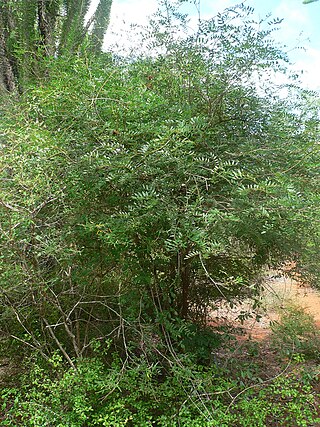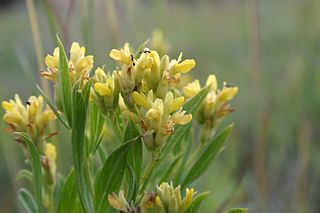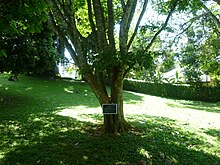
Cassia is a genus of flowering plants in the legume family, Fabaceae, and the subfamily Caesalpinioideae. Species are known commonly as cassias. The genus includes 37 species and has a pantropical distribution. Species of the genera Senna and Chamaecrista were previously included in Cassia. Cassia now generally includes the largest species of the legume subtribe Cassiinae, usually mid-sized to tall trees.

Xanthocercis is a tree genus in the family Fabaceae. It includes three species native to sub-Saharan Africa.
Angylocalyx is a genus of flowering plants in the family Fabaceae. It includes seven species native to sub-Saharan Africa, ranging from Guinea to Angola, Tanzania, and Kenya.

Cordyla is a genus of flowering plants in the family Fabaceae. It includes seven species native to sub-Saharan Africa, ranging across northern Africa from Senegal to Somalia, and through eastern Africa from Sudan to KwaZulu-Natal, including Madagascar.

Gigasiphon is a genus of plants in the family Fabaceae. The genus is circumscribed is defined by "a long-tubular hypanthium, an arborescent habit, and a calyx divided into two lobes." It includes five species native to eastern Africa, Madagascar, the Philippines, New Guinea, and Lesser Sunda Islands.
Haplormosia is a monotypic genus of legumes in the family Fabaceae. Its only species is Haplormosia monophylla, commonly known as Liberian black gum, native to Cameroon, Ivory Coast, Liberia, Nigeria, and Sierra Leone. It is threatened by habitat loss.

Myrocarpus is a genus of flowering plants in the family Fabaceae. It includes five species of trees native to tropical South America, ranging from Venezuela to northern Argentina. Typical habitats include wet to seasonally-dry tropical lowland forest and woodland.
Neoharmsia is a genus of legume in the family Fabaceae. It includes two species of trees or shrubs endemic to Madagascar. Typical habitats are seasonally-dry tropical woodland and succulent thicket or woodland, on limestone or coastal sand, in the northern and western parts of the island.
Ormocarpopsis is a genus of flowering plants in the family Fabaceae. It includes eight species of shrubs or small trees endemic to Madagascar. They inhabit seasonally-dry tropical forest, woodland, and xerophytic shrubland, sometimes on rocky outcrops of sandstone or limestone. They are found throughout the island except in the eastern lowland rain forest. The genus was recently assigned to the informal monophyletic Dalbergia clade of the Dalbergieae. It contains the following species:

Ormosia is a genus of legumes. 131 living species, mostly trees or large shrubs, are native to the tropical Americas, from southwestern Mexico to Bolivia and southern Brazil, to southern, southeastern, and eastern Asia, and to New Guinea and Queensland. Most are tropical, while some extend into temperate temperate regions of China. A few species are threatened by habitat destruction, while the Hainan ormosia is probably extinct already.
Orphanodendron is a genus of legume in the legume family, Fabaceae. It includes two species of trees native to Colombia, which grow in tropical lowland forest. The genus is in subfamily Faboideae.

Pearsonia is a genus of 12 species of plants belonging to the family Fabaceae and occurring in Africa south of the equator with 1 species found on Madagascar. The species are usually herbs or shrublets with woody rootstocks. Leaves are usually sessile and 3-foliolate. The inflorescence is a congested or lax terminal raceme. The name of this genus commemorates the South African botanist Henry Harold Welch Pearson.

Barklya is a genus of Australian trees in the legume family, Fabaceae. It belongs to the subfamily Cercidoideae. The sole species is Barklya syringifolia, commonly known as golden crown or golden glory. It grows in rainforest to 20 metres tall. Recorded from Queensland and New South Wales in rain forest. It is often used as an ornamental.

Griffonia is a genus of central African flowering plants in the legume family, Fabaceae. It belongs to the subfamily Cercidoideae. Griffonia is known to have a high concentration of 5-HTP in its seeds.

Piliostigma is a genus of flowering plants in the legume family, Fabaceae. It includes five species of small deciduous trees native to sub-Saharan Africa, the Indian subcontinent, Indochina, Java, the Philippines, and northern Australia. It belongs to the subfamily Cercidoideae and the tribe Bauhinieae. It is dioecious, with male and female flowers on separate plants.

Brya is a genus of flowering plants in the legume family, Fabaceae. It includes seven species of shrubs or small spreading trees native to Cuba and Hispaniola in the Caribbean. It belongs to the subfamily Faboideae, and was recently assigned to the informal monophyletic Pterocarpus clade of the Dalbergieae. Species include Brya ebenus, a valuable timber tree.
Candolleodendron brachystachyum is a species of flowering plant in the legume family, Fabaceae. It belongs to the subfamily Faboideae. It is the only member of the genus Candolleodendron. It is a tree native to the Amazon rain forest of northern Brazil (Pará), Suriname, and French Guiana.

Hypocalyptus is a genus of flowering plants in the legume family, Fabaceae. It includes three species of shrubs, subshrubs or small trees native to the Cape region of South Africa. Typical habitats include Mediterranean-climate shrubland (fynbos) at forest margins, in rocky and sandy areas, and along streams, often at high elevations.
Mildbraediodendron excelsum is a species of flowering plant in the family Fabaceae, and the only species in the genus Mildbraediodendron. It is a tree native to sub-Saharan Africa, ranging from Ghana to South Sudan, Uganda, and Democratic Republic of the Congo. It grows in Guineo-Congolian forest and Victoria Basin forest–savanna mosaic. It belongs to the subfamily Faboideae.
Monopteryx is a genus of flowering plants in the family Fabaceae. It includes three species of trees native to the Amazon rainforest of northern South America, ranging through parts of Colombia, Venezuela, northern Brazil, and French Guiana. They grow in non-inundated lowland tropical rain forest on sandy soil. The genus belongs to subfamily Faboideae. Members of this genus produce hydroxypipecolic acids in their leaves.












